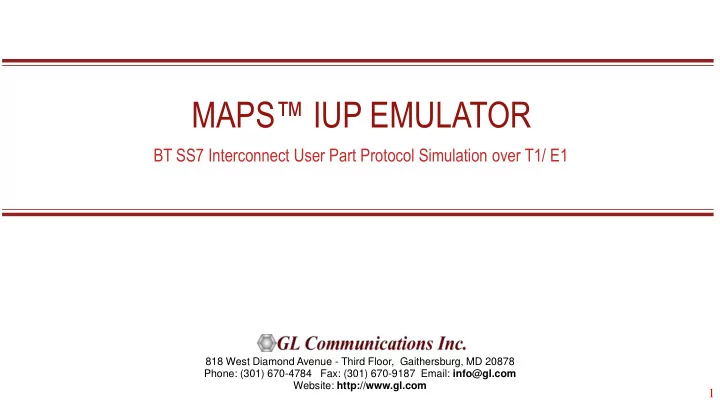

MAPS™ IUP EMULATOR BT SS7 Interconnect User Part Protocol Simulation over T1/ E1 818 West Diamond Avenue - Third Floor, Gaithersburg, MD 20878 Phone: (301) 670-4784 Fax: (301) 670-9187 Email: info@gl.com Website: http://www.gl.com 1
MAPS™ IUP 2
Main Features • IUP simulation over TDM (T1/E1) • Multiple T1/E1 line interfaces supported • Supported procedures include Basic Call Service protocol (IFAM, IAM, ACI, Bearer Establishment), Request Service protocol, Nodal End-to-End Data protocol, Enveloped ISUP Essential Service protocol, and ISDN Call Handling Service protocol • Supports generation & detection of TDM traffic - Auto Traffic Voice, Digits, Tones, IVR, FAX, Dynamic VF, and User-defined traffic • User-friendly GUI for configuring the SS7 MTP Layers • User Configurable Signalling Links • User-configured Circuit Mapping, i.e., defines Circuit Identification Codes (CIC) and map these CICs to Timeslots/Trunks in order to enable Voice/Data traffic • Supports MTP2 and MTP3 protocol machine • Multiple MTP links 3
Supported Protocol Standards Supported Protocols Standard / Specification Used ND1006:2007/05 TSG/SPEC/006 (IUP) ND1104:2004/11 PNO-ISC/INFO/004 (Proprietary Extensions to IUP) IUP ND1301:2001/03 DPNSS (Digital Private Signalling System No 1 (DPNSS 1) ) ISDN User Part (ISUP) UK - ND1007:2001/07 PNO-ISC/SPEC/007 MTP3 UK ITU-T Recommendation Q.703 MTP2 UK T-REC-Q.703-199607 4
Supported IUP Procedures Listed below are the some of the IUP Procedures supported by MAPS™ IUP • Basic Call Service: (Service Handling Protocol) ➢ IFAM Protocol ➢ IAM (SND) Protocol ➢ IAM (SAD) Protocol ➢ Subsequent Address Message (SAM) ➢ Final Address Message (FAM) • Call Establishment ➢ IUP Basic Call Service: (Service Handling Protocol) ➢ Request Service protocol (Service Handling Protocol 2) ➢ SASUI Protocol (Supplementary Call Information) ➢ ACI Protocol (Supplementary Call Information) ➢ Nodal End-to-End Data Protocol (Service Handling Protocol 3) ➢ ISDN Call Protocol (Service Handling Protocol 1) ➢ Enveloped ISUP Essential (Service Handling Protocol 8) • Call Supervision: ➢ Connection not completed – SUBSCRIBER ENGAGED or SUBSCRIBER OUT • Call Release Procedures ➢ Connection not completed – CNA procedures ➢ Connection not completed – RELEASE procedures ➢ Bearer Release Protocols 5
IUP Call Flow Scenario Basic (telephony) Service Handling Protocol 6
IUP Call Flow Scenario Enveloped ISUP Call Procedure 7
Testbed Configuration 8
Profile Configuration 9
Incoming Call Handler Configuration 10
IUP Incoming Call Handler Configuration WCS Connection Log MTP3 Script 11
IUP Call Generation (Outgoing Network) 12
IUP Call Reception (Incoming Network) 13
IUP Message Statistics 14
IUP Call Event Log Event Log WCS Server Traffic Log 15
Load Generation • Stability/Stress and Performance testing using Load Generation • Different types of Load patterns to distribute load • User can load multiple patterns for selected script • User configurable Test Duration, CPS, Maximum and Minimum Call Rate etc. Fixed Ramp Uniform Normal Saw-tooth Step 16
IUP Bulk Call Generation 17
IUP Call Ratio Statistics Call Graph Call Stats 18
IUP CLI 19
IUP CLI Network Node and Server Incoming Network Node MAPS CLI Server 20
CLI Support 1 21
Customizations - Call Flow (Scripts) • Scripts are written in our proprietary *.gls scripting language. They represent generic state machines intended provide protocol/signaling logic for a call and establish bearer traffic. • It is pEach instance of a script corresponds to a single transaction/call, i.e., if you place 500 calls in parallel you will actually have 500 script instances running at once. If you place 500 calls in series the same script terminate 500 times. • Possible to create your own scripts, but almost never necessary! We attempt to provide all necessary scripts out of the box. 22
Customizations - Protocol Messages When the script actually sends a message it does so by loading a hdl file template from disk (“SGsAP - PAGING- REQUEST.hdl” in the right hand screenshot). These message templates provide the actual structure of the message, the script simply populates it with values contained in its variables. These messages are customizable by the user, header fields can be altered and removed. Binary- based messages are edited in our provided message editor. 23
Customizations - User Events 24
Customizations - Statistics and Reports MOS, R-Factor Packet Loss Packets Discarded Duplicate Packets Out-Of-Sequence Packets Call Stats provide a running tabular log of system level Jitter Statistics stats, tracked stats include: Total Calls, Active Calls, Completed Calls, Passed Calls, Failed Calls, Instantaneous Calls/Sec 25
MAPS™ API Architecture • API wraps our proprietary scripting language in standard languages familiar to the user: Python ➢ Java ➢ VB Scripts ➢ TCL ➢ • Clients and Servers support a “Many -to- Many” relationship, making it very easy for users to develop complex test cases involving multiple signaling protocols. 26
API Architecture... System Integration • The same Client Application used to control MAPS™ can be, and very often is, used to control other elements of the System Under Test. 27
API Architecture... System Integration • Client Application can be as simple as executing a script from an IDE or it can be integrated into a full- fledged automation test suite like QualiSystems TestShell or HP UFT . 28
API Architecture... 29
APIs High Level vs Low Level • The API is broken into High and Low level function calls / scripts. • For High Level scripts, all the fine-grained protocol control happen in the script running on the MAPS server, hidden from the API user. • Low Level scripts put the API user in complete control of the protocol stack. This makes Low Level scripts more flexible and powerful, but also correspondingly more complex. 30
Thank You 31
Recommend
More recommend